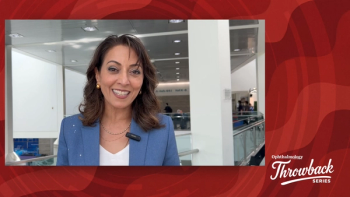
Ecabet shows promise for dry eye in phase IIb study results
Ecabet sodium (ISTA Pharmaceuticals), an anti-ulcer and gastritis drug under development for the treatment of dry eye, showed positive results in a phase IIb clinical trial of the drug.
Key Points
Irvine, CA-Ecabet sodium, an anti-ulcer and gastritis drug, is being developed for the treatment of the signs and symptoms of dry eye disease. Jan. 22, ISTA Pharmaceuticals announced the positive results of the phase IIb clinical trial of the drug.
"The patients treated with ecabet achieved a strong positive trend in the objective sign of tear film break-up time [TFBUT] and a positive trend in the objective sign of the quantity of tears produced on Schirmer testing," said Tim McNamara, PharmD, vice president of clinical research and medical affairs, ISTA Pharmaceuticals.
Ecabet is a mucin secretagogue that works by increasing the quantity of mucin produced by conjunctival goblet cells, he said. Mucin, a component of tear film, provides lubrication and prevents moisture loss from evaporation of tears. "The rationale behind the use of this drug is that by increasing the mucin, we should be able to improve the quality of the tear film," he said.
Phase IIb study results
A total of 144 patients with all severities of dry eye disease participated in the phase IIb study. Half of them received the study drug and the other half received placebo. The patients were randomly assigned to the active treatment group or the placebo group. The patients in both groups instilled the drops four times a day for 43 days. A 3% concentration of ecabet was used in the study.
Commenting on the results, Dr. McNamara reported, "There was a strong positive trend for the objective sign of TFBUT, an indicator of the quality of tears. In addition, there was a positive trend for the objective sign of the quantity of tears measured using the Schirmer's test."
The investigators performed anesthetized and unanesthetized Schirmer's tests, both of which showed trends toward efficacy of the drug. No such trends were seen in the patients who were randomly assigned to receive placebo for either of the objective signs.
When the investigators did an analysis of responders in both study groups, they found that the results of the anesthetized Schirmer's test showed a strong trend for ecabet that approached statistical significance compared with placebo.
"This is a strong indicator in a study that is not powered to show significant differences," he said.
The most important finding of the anesthetized Schirmer's test was that it indicates that the drug has a positive effect on basal tear secretion, Dr. McNamara said.
The unanesthetized Schirmer's test affects both basal tear secretion and reflex tear secretion caused by irritation. The investigators were confident that increased tears were being produced, he said.
The trend toward increased tear secretion was seen about midway through the study, at day 22, and it continued to trend upward through the end of the study, at day 43, Dr. McNamara reported.
No severe ocular or systemic adverse effects were seen with ecabet; any minor adverse effects did not differ from those of placebo, he said.
A second phase II study
The investigators also are expecting results from another phase II study of a lower concentration of bromfenac (Xibrom) versus placebo to treat the signs and symptoms of dry eye disease. Bromfenac has an anti-inflammatory mechanism of action, which they said they hope will be effective for the inflammatory component of dry eye disease, according to Dr. McNamara. Results are expected in the first quarter of this year.
With data sets available for both drugs, the company then will assess whether one or both drugs merit further study.
"We will then be able to make informed decisions about our dry eye franchise," he said. "Do we develop one drug or the other drug, or do we develop both at the same time?"
Phase III trials could begin in 2010, Dr. McNamara added.
A place in the dry eye market
He said he sees a place for ecabet in the marketplace. Dr. McNamara said that cyclosporine (Restasis, Allergan) works in a small percentage of patients, can produce stinging on instillation, and requires an extended time to work. In contrast, patient comfort was not a significant issue in the study of ecabet, and positive results were seen fairly early on in the patients treated with the drop; this finding has to be confirmed in a phase III study, he said.
"Ecabet gives patients another option for treating dry eye," Dr. McNamara said. "Tears do not meet the demands of these patients, and cyclosporine can take a long time. We believe that ecabet can provide clinical benefit to patients who need another option.
"We hope to get the drug approved and that ultimately it will be a first-line agent for treating patients with dry eye disease," he added. "We hope that a substantial number of patients will benefit from treatment with ecabet."
Newsletter
Don’t miss out—get Ophthalmology Times updates on the latest clinical advancements and expert interviews, straight to your inbox.


















































.png)


